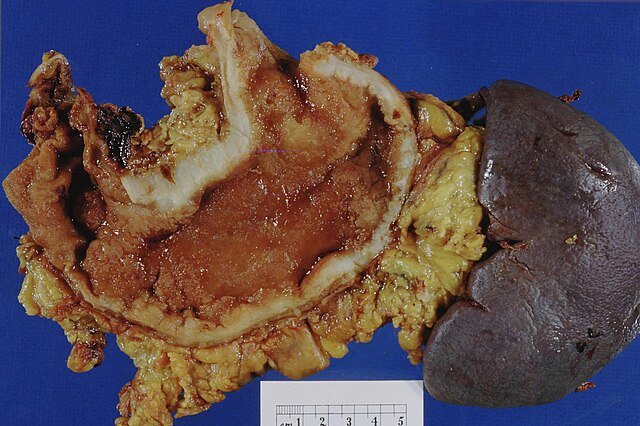Gastric Cancer
content of this page
1- Introduction
2-Key Definitions
3- Clinical Features & Examination Tips
4- Investigations & Interpretation
5- Pathophysiology
6- Symptoms
7- Treatment
Introduction
Gastric cancer is the fifth most common cancer worldwide, with high mortality. Around 90% are adenocarcinomas, arising from the gastric mucosa, most often against a background of chronic atrophic gastritis and intestinal metaplasia. It presents late in Western countries but is often caught early in countries like Japan due to screening.

Key Definitions
Adenocarcinoma: Malignant tumour of gland-forming epithelial cells.
Intestinal type: Well-differentiated, arises from intestinal metaplasia.
Diffuse type: Poorly differentiated, infiltrates stomach wall (e.g. linitis plastica).
Early gastric cancer: Confined to mucosa/submucosa.
CDH1 mutation: Associated with hereditary diffuse gastric cancer.
Clinical Features & Examination Tips
–Early disease is often asymptomatic, diagnosed via endoscopy for dyspepsia.
In advanced disease, symptoms include:
Weight loss (66%)
Epigastric pain (50%)
Anorexia, nausea
Early satiety
Anaemia (from occult bleeding)
Dysphagia (cardia involvement)
Haematemesis, melaena (less common)
–Examination findings:
Weight loss, pallor, epigastric mass
Virchow’s node (left supraclavicular)
Sister Mary Joseph nodule (umbilicus)
Krukenberg tumour (ovary metastasis)
Paraneoplastic signs: Trousseau’s sign, acanthosis nigricans
Investigations & Interpretation
–Initial test:
Upper GI endoscopy + multiple biopsies
–Staging:
CT, EUS (endoscopic ultrasound)
Laparoscopy for assessing peritoneal spread
-Consider testing for HER2 (for targeted therapy like trastuzumab)
Pathophysiology
Most cases arise after a long-term sequence:
H. pylori infection → chronic gastritis → atrophy → intestinal metaplasia → dysplasia → carcinomaH. pylori is a definite carcinogen (IARC class I) and may be responsible for ~70% of gastric cancers
Risk increases with dietary nitrites, smoked foods, autoimmune gastritis, family history, and CDH1 mutation
Intestinal-type arises from metaplastic mucosa; diffuse-type arises de novo and is often more aggressive
Symptoms
Persistent epigastric pain
Weight loss
Vomiting, nausea
Iron-deficiency anaemia
Early satiety (due to mass effect)
Dysphagia if near the gastroesophageal junction
Treatment
–Curative (Early Cancer):
Endoscopic resection (if limited to mucosa/submucosa)
Surgical resection (total/partial gastrectomy + lymphadenectomy)
Billroth I / Roux-en-Y reconstruction depending on location
–Perioperative chemotherapy:
ECF regimen: Epirubicin + Cisplatin + 5-FU
Post-op chemo or chemoradiotherapy if not given pre-op
–Palliative (Advanced/Metastatic):
Chemotherapy ± trastuzumab (if HER2+)
Endoscopic stenting, laser therapy for obstruction/bleeding
Palliative surgery in selected cases